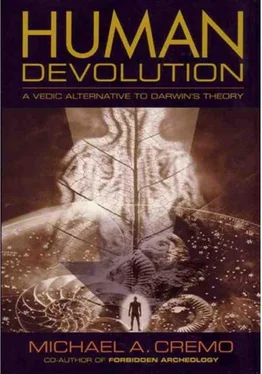Michael Cremo - Human Devolution - A Vedic Alternative To Darwin's Theory
Здесь есть возможность читать онлайн «Michael Cremo - Human Devolution - A Vedic Alternative To Darwin's Theory» весь текст электронной книги совершенно бесплатно (целиком полную версию без сокращений). В некоторых случаях можно слушать аудио, скачать через торрент в формате fb2 и присутствует краткое содержание. Год выпуска: 2003, ISBN: 2003, Издательство: Torchlight Publishing, Жанр: Старинная литература, на английском языке. Описание произведения, (предисловие) а так же отзывы посетителей доступны на портале библиотеки ЛибКат.
- Название:Human Devolution: A Vedic Alternative To Darwin's Theory
- Автор:
- Издательство:Torchlight Publishing
- Жанр:
- Год:2003
- ISBN:9780892133345
- Рейтинг книги:4 / 5. Голосов: 1
-
Избранное:Добавить в избранное
- Отзывы:
-
Ваша оценка:
- 80
- 1
- 2
- 3
- 4
- 5
Human Devolution: A Vedic Alternative To Darwin's Theory: краткое содержание, описание и аннотация
Предлагаем к чтению аннотацию, описание, краткое содержание или предисловие (зависит от того, что написал сам автор книги «Human Devolution: A Vedic Alternative To Darwin's Theory»). Если вы не нашли необходимую информацию о книге — напишите в комментариях, мы постараемся отыскать её.
Human Devolution: A Vedic Alternative To Darwin's Theory — читать онлайн бесплатно полную книгу (весь текст) целиком
Ниже представлен текст книги, разбитый по страницам. Система сохранения места последней прочитанной страницы, позволяет с удобством читать онлайн бесплатно книгу «Human Devolution: A Vedic Alternative To Darwin's Theory», без необходимости каждый раз заново искать на чём Вы остановились. Поставьте закладку, и сможете в любой момент перейти на страницу, на которой закончили чтение.
Интервал:
Закладка:
Also, both artificial intelligence (AI) and artificial life (Alife) researchers have failed to provide convincing models of living things. Rodney Brooks, of the Artificial Intelligence Laboratory at MIT, wrote in a perceptive article in nature: “Neither AI or Alife has produced artifacts that could be confused with a living organism for more than an instant. AI just does not seem as present or aware as even a simple animal and Alife cannot match the complexities of the simplest forms of life”
(Brooks 2001, p. 409). Brooks attributes the failure to something other than lack of computer power, incorrect parameters, or insufficiently complex models. He raises the possibility that “we are missing something fundamental and currently unimagined in our models.” But what is that missing something? “One possibility,” says Brooks (2001, p. 410), “is that some aspect of living systems is invisible to us right now. The current scientific view of things is that they are machines whose components are biomolecules. It is not completely impossible that we might discover new properties of biomolecules, or some new ingredient. . . . Let us call this the ‘new stuff’ hypothesis—the hypothesis that there might be some extra sort of ‘stuff’ in living systems outside our current scientific understanding.” And what might this new stuff be? Brooks gives David Chalmers as an example of a philosopher who proposes that consciousness might be a currently unrecognized state of matter. But Brooks (2001, p.
411) goes on to say, “Other philosophers, both natural and religious, might hypothesize some more ineffable entity such as a soul or elan vital —the ‘vital force.’” Going along with such philosophers, I would propose that both a soul (conscious self) and vital force are present in humans and other living things. This conscious self and vital force are necessary components in any explanation of living things and their origins.
Beyond Stones and Bones:
Alfred R. Wallace and the Spirit World
If, as the evidence in Forbidden Archeology suggests, we did not evolve from primitive apes by a process of Darwinian evolution, then where did we come from? To properly answer this question, we must first critically examine our fundamental assumptions about observable nature. If we confine ourselves to current assumptions about observable nature held by mainstream science, this limits the kinds of alternative explanations of human origins it is possible to present. Mainstream science assumes that all phenomena in observable nature are the result of the actions of ordinary matter, operating according to ordinary physical and chemical laws.
There are, I am convinced, some very good reasons why we should modify the assumptions about observable nature currently held by mainstream science. Many of these reasons can be found in a curious place
—the work of one of the founders of the theory of evolution by natural selection.
In 1854, a young English naturalist named Alfred Russel Wallace journeyed to the East Indies to collect wildlife specimens. During his travels, he was intrigued by the patterns of variation among plants and animals throughout the region. In 1858, while laid up with a tropical disease, he took a couple of days to write a scientific paper explaining the origin of such variations. He then sent the paper to Charles Darwin for comments before publication. Darwin, back in England, had been working since 1844 on a book explaining the origin of species by evolution through natural selection. He was shocked to find that Wallace, a relatively unknown naturalist, was about to publish a paper outlining the whole idea. In the scientific world, priority is everything. The person who first publishes an idea or theory receives credit for it. Darwin, somewhat anxious about his priority, consulted some of his close scientific friends. On their advice, he proposed to Wallace that they co-author a paper on evolution. Wallace agreed, insuring his lasting fame, alongside Darwin, as one of the world’s great scientists. Interestingly enough, Wallace, the cofounder with Darwin of the theory of evolution by natural selection, became involved in paranormal research.
Modern biology and anthropology texts often contain biographical sketches of Alfred Russel Wallace. But these idealized sketches routinely ignore Wallace’s extensive research into the paranormal and his related conclusions, portraying him instead as a saint of materialism. This slanted hagiography is arguably related to the authors’ cultural commitment to materialist, reductionist cosmologies.
The central feature of Wallace’s paranormal research was his belief in spirits and a spirit world. On the basis of personal experiments and reliable reports from other scientists, Wallace concluded that the universe is populated with a hierarchy of spirit beings, some of whom are in contact with the human population on earth, usually through mediums. According to Wallace, the spirit beings lower in the hierarchy, acting through mediums, were responsible for a variety of paranormal phenomena, including clairvoyance, miraculous healings, communications from the dead, apparitions, materializations of physical objects, levitations, etc. More powerful spirit beings may have played a role in the process of evolution, guiding it in certain directions.
Spirits, the kind that can move matter, are the last thing today’s evolutionists want to hear about. Such things threaten current evolutionary theory, which depends on philosophical naturalism—the idea that everything in nature happens according to known physical laws. Introduce nonmaterial entities and effects, and the theory of evolution loses its exclusivity as an explanation for the origin of species. Perhaps spirits were involved in the process. If so, one would have to consider “supernatural selection” in addition to natural selection.
In addition to believing in spirits, Wallace also believed that anatomically modern humans were of considerable antiquity. For example, he accepted the discoveries of J. D. Whitney, which, by modern geological reckoning, place humans in California up to 50 million years ago (Cremo and Thompson 1993, pp. 368–394, 439–458). Wallace noted that such evidence tended to be “attacked with all the weapons of doubt, accusation, and ridicule” (Wallace 1887, p. 667). Wallace suggested that “the proper way to treat evidence as to man’s antiquity is to place it on record, and admit it provisionally wherever it would be held adequate in the case of other animals; not, as is too often now the case, to ignore it as unworthy of acceptance or subject its discoverers to indiscriminate accusations of being impostors or the victims of impostors” (Wallace 1887, p. 667).
Wallace encountered the same kind of opposition when he communicated to scientists the results of his spiritualistic research. Describing the reactions of the public and his scientific colleagues, Wallace wrote in his autobiography: “The majority of people today have been brought up in the belief that miracles, ghosts, and the whole series of strange phenomena here described cannot exist; that they are contrary to the laws of nature; that they are the superstitions of a bygone age; and that therefore they are necessarily either impostures or delusions. There is no place in the fabric of their thought into which such facts can be fitted. When I first began this inquiry it was the same with myself. The facts did not fit into my then existing fabric of thought. All my preconceptions, all my knowledge, all my belief in the supremacy of science and of natural law were against the possibility of such phenomena. And even when, one by one, the facts were forced upon me without possibility of escape from them, still, as Sir David Brewster declared after being at first astonished by the phenomena he saw with Mr. Home, ‘spirit was the last thing I could give in to.’ Every other possible solution was tried and rejected. Unknown laws of nature were found to be of no avail when there was always an unknown intelligence behind the phenomena—an intelligence that showed a human character and individuality, and an individuality which almost invariably claimed to be that of some person who had lived on earth, and who, in many cases, was able to prove his or her identity. Thus, little by little, a place was made in my fabric of thought, first for all such well-attested facts, and then, but more slowly, for the spiritualistic interpretation of them. . . . Many people think that when I and others publish accounts of such phenomena, we wish or require our readers to believe them on our testimony. But that is not the case. Neither I nor any other well-instructed spiritualist expects anything of the kind. We write not to convince, but to excite inquiry. We ask our readers not for belief, but for doubt of their own infallibility on this question; we ask for inquiry and patient experiment before hastily concluding that we are, all of us, mere dupes and idiots as regards a subject to which we have devoted our best mental faculties and powers of observation for many years” (Wallace 1905, v. 2, pp.
Читать дальшеИнтервал:
Закладка:
Похожие книги на «Human Devolution: A Vedic Alternative To Darwin's Theory»
Представляем Вашему вниманию похожие книги на «Human Devolution: A Vedic Alternative To Darwin's Theory» списком для выбора. Мы отобрали схожую по названию и смыслу литературу в надежде предоставить читателям больше вариантов отыскать новые, интересные, ещё непрочитанные произведения.
Обсуждение, отзывы о книге «Human Devolution: A Vedic Alternative To Darwin's Theory» и просто собственные мнения читателей. Оставьте ваши комментарии, напишите, что Вы думаете о произведении, его смысле или главных героях. Укажите что конкретно понравилось, а что нет, и почему Вы так считаете.












